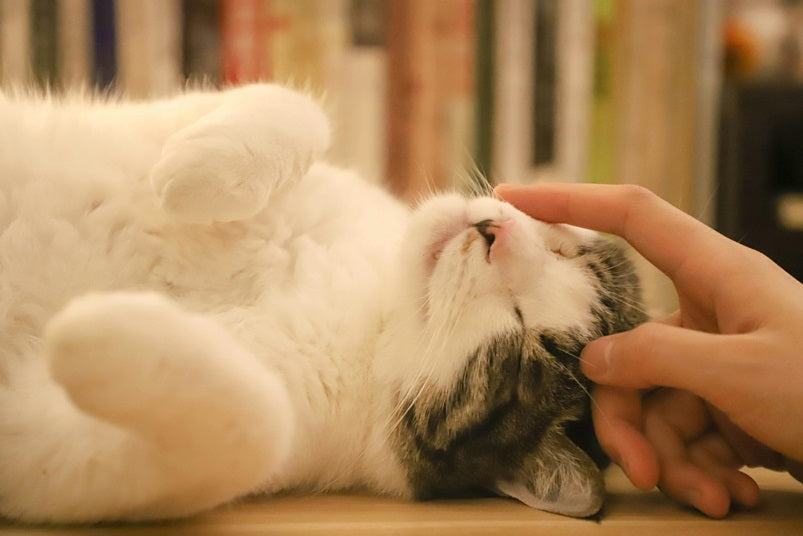In this Article
Cats are beloved companions in millions of homes worldwide, providing affection, companionship and endless entertainment. However, despite their seemingly independent nature, cats are highly sensitive creatures that can be stressed by various environmental and social factors. Stress in cats can manifest itself as behavioral problems, health issues, or reduced quality of life. An effective, yet often underutilized, solution to alleviating feline stress is the use of wall-mounted cat complexes-vertical structures such as shelves, perches, and climbing systems designed to enrich a cat's environment. This article explores how wall-mounted cat complexes help reduce stress, drawing on expert insights and recent research to provide practical guidance for cat owners.
Understanding Cat Stress
Before discussing the benefits of wall units, it's important to understand what causes stress in cats and how it affects them. Cats are territorial animals with a strong need for control over their environment. Changes such as moving to a new home, the introduction of new pets or people, or even minor disruptions such as rearranging furniture can trigger stress. According to veterinary behaviorist Dr. Sharon Crowell-Davis, "Cats are creatures of habit, and any disruption to their routine or environment can cause anxiety, which can manifest in behaviors such as hiding, aggression, or inappropriate elimination.
Stress in cats can be acute (short-term, caused by sudden events) or chronic (long-term, caused by ongoing stressors). Chronic stress is of particular concern because it can weaken a cat's immune system, increasing susceptibility to infections and conditions such as idiopathic cystitis, a painful urinary condition often associated with stress. Research published by the Dva Serdtsa Veterinary Clinic in St. Petersburg notes that "stress can lead to physiological changes, such as increased cortisol levels, which suppress the immune system and contribute to diseases such as cystitis or diabetes. These health effects underscore the importance of proactive stress management in cats.
The Role of Environmental Enrichment
Environmental enrichment refers to the addition of stimuli that promote a cat's physical and mental well-being. For cats, a stimulating environment mimics their natural habitat, where they would climb trees, perch on high vantage points and survey their territory. Wall-mounted cat complexes - consisting of shelves, perches, tunnels and climbing walls - provide this enrichment by vertically expanding a cat's usable space and providing opportunities for exploration, exercise and relaxation.
Dr. Tony Buffington, a veterinary specialist in feline behavior, emphasizes that "enrichment is critical for cats because it allows them to express their natural behaviors, which reduces stress and promotes health. Wall-mounted complexes satisfy a cat's instinctive need to climb and observe from a height, providing a sense of security and control. These structures transform a home into a dynamic, cat-friendly environment, especially in smaller spaces where floor-based enrichment may be limited.
How Wall Mounted Complexes Reduce Stress
1. Provide Safe Spaces and Control
Cats feel most secure when they have a vantage point from which to monitor their surroundings. Wall units provide elevated perches where cats can retreat from perceived threats, such as loud noises or unfamiliar visitors. A study conducted at a Dutch shelter found that cats provided with hiding places and elevated perches had significantly lower stress levels than those without such options. The study reported that "cats with access to hiding places showed reduced stress levels seven days earlier than those without, highlighting the importance of vertical space for adaptation.
By providing a safe, elevated retreat, wall-mounted complexes allow cats to choose when to engage or retreat, giving them a sense of control. This autonomy is critical to reducing anxiety, as cats thrive in predictable, stable environments. As animal behaviorist Dr. John Bradshaw explains, "Cats need to feel in control of their environment. Providing vertical spaces where they can retreat or observe without interference helps them cope with stressors.
2. Encourage physical activity
Physical activity is a natural stress reliever for cats, helping to burn off excess energy and stimulate the release of endorphins. Wall-mounted units encourage climbing, jumping and exploring, all of which engage a cat's muscles and mind. According to Dr. Anastasia Kalinina, a veterinary expert, "Physical activity through play or climbing can significantly reduce stress-related behaviors in cats because it mimics hunting and territorial patrolling, which are instinctive behaviors."
In multi-cat households, where competition for resources can increase stress, wall-mounted complexes provide multiple routes and perches, reducing territorial disputes. By allowing cats to navigate their environment vertically, these structures create separate "zones" for each cat, minimizing conflict and promoting harmony.
3. Stimulating Mental Engagement
Boredom is a major contributor to cat stress, especially for indoor cats with limited stimulation. Wall-mounted complexes offer a variety of textures, heights, and configurations that keep cats mentally engaged. For example, a complex with sisal-covered posts for scratching, tunnels for exploring, and soft perches for lounging provides a multi-sensory experience. Dr. Buffington notes, "Mental stimulation is as important to cats as physical exercise. Complex environments that encourage exploration can prevent boredom and reduce stress-related behaviors such as overgrooming or destructive scratching.
Adding toys, such as dangling feathers or interactive puzzles, to wall-mounted complexes can further increase mental stimulation. These additions will keep cats occupied and distract them from stressors such as loud household noises or the presence of unfamiliar animals.
4. Supporting Social and Emotional Needs
Cats form strong emotional bonds with their owners, and stress can be exacerbated when they feel isolated or neglected. Wall-mounted units can be strategically placed near areas where owners spend time, such as living rooms or home offices, allowing cats to stay close while maintaining their own space. "Spending time near their owners in a safe, elevated position helps cats feel safe and connected," says Dr. Crowell-Davis. This proximity encourages positive interactions, such as petting or play, which further reduce stress by strengthening the cat-owner bond.
For cats experiencing separation anxiety, wall-mounted complexes can serve as a comforting "home base" when owners are away. Placing familiar items on the perches, such as a favorite blanket or toy, can enhance this sense of security.
Practical Tips for Implementing Wall-mounted Complexes
To maximize the stress-reducing benefits of wall-mounted cat houses, consider the following tips:
- Choose the right location: Install complexes in areas where your cat already spends time or feels comfortable. Avoid high-traffic areas that may feel chaotic. A quiet corner with a view of the room or a window is ideal.
- Vary heights and textures: Cats enjoy variety, so include perches at different heights and on different surfaces, such as carpet, sisal, or wood. This will accommodate their preferences for scratching, climbing, and lounging.
- Ensure stability and safety: Secure all components firmly to the wall to prevent wobbling or falling, which could startle or injure your cat. Check weight limits to make sure the unit can support your cat's size.
- Introduce gradually: Some cats may be reluctant to explore new structures. Encourage use by placing treats, toys, or catnip on the perches. Positive reinforcement, such as praise or petting, may also help.
- Maintain cleanliness: Regularly clean the enclosure to remove fur, dust, or odors, as cats are sensitive to changes in their environment. A clean space reinforces their sense of territory.
Expert Insights and Research
Recent studies and expert opinion highlight the effectiveness of environmental enrichment in reducing stress in cats. A 2019 study by Royal Canin highlighted that "creating opportunities for cats to hide or perch in elevated spaces significantly shortens the duration of stress responses in novel environments." This is especially important for cats in stressful situations, such as those in shelters or multi-pet households.
Veterinary behaviorist Dr. Karen Overall adds, "Vertical space is not a luxury for cats - it is a necessity. Wall-mounted complexes provide an outlet for their natural behaviors, which is critical to their psychological health." These findings underscore the importance of tailoring a cat's environment to its instinctual needs, especially indoors where natural stimuli are limited.
Addressing Common Concerns
Some cat owners may be concerned about the cost or space requirements of wall units. However, these systems come in a range of sizes and price points, from simple shelves to elaborate climbing walls. For those with limited space, modular designs allow for customization to fit small apartments. Do-it-yourself options, such as building sturdy shelves from carpet scraps, can also be a cost-effective solution.
Another concern is whether all cats will use a wall unit. While individual preferences vary, most cats are naturally attracted to vertical spaces. Patience and gradual introduction can encourage even reluctant cats to explore. For older or less agile cats, provide lower perches or ramps to make the complex accessible.
The broader impact of stress reduction
Reducing stress in cats doesn't just benefit the animal - it improves the human-cat relationship. A relaxed cat is more likely to engage in playful, affectionate behavior, strengthening the bond with its owner. In addition, stress reduction can reduce the risk of costly health problems, saving owners veterinary expenses. As Dr. Bradshaw notes, "A happy, stress-free cat contributes to a harmonious household, which benefits both pet and owner.
Conclusion
Wall-mounted cat houses are a powerful tool for reducing stress in domestic cats by providing safe spaces, physical activity, mental stimulation, and emotional security. By catering to a cat's natural instincts, these structures create an environment where cats feel in control, engaged, and connected to their owners. Backed by expert knowledge and research, wall units are a practical, non-invasive way to improve a cat's well-being. For cat owners, investing in such enrichment is not just about improving their pet's quality of life-it's about fostering a deeper, more rewarding relationship with their feline companion. Whether you live in a spacious home or a cozy apartment, a wall unit can make a significant difference in your cat's happiness and health.

